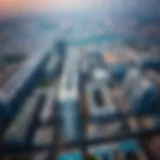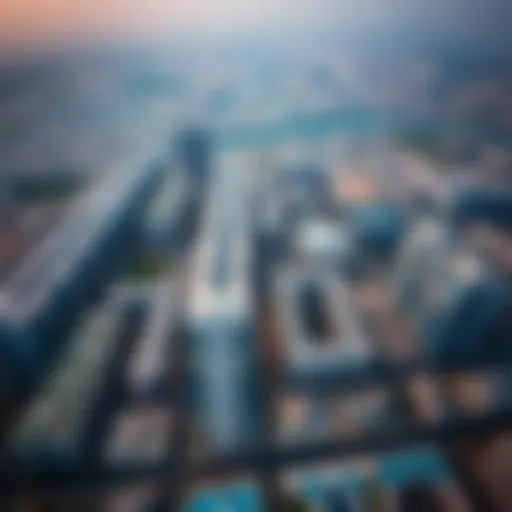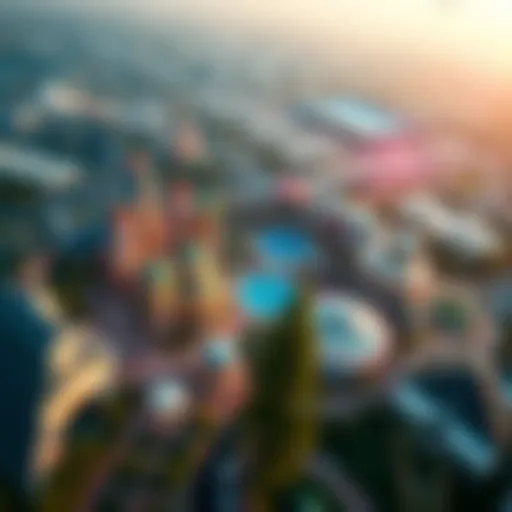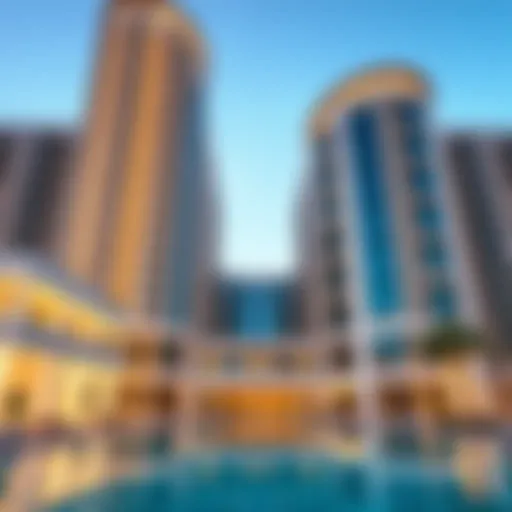Exploring Saif Tower: A Key Dubai Skyscraper
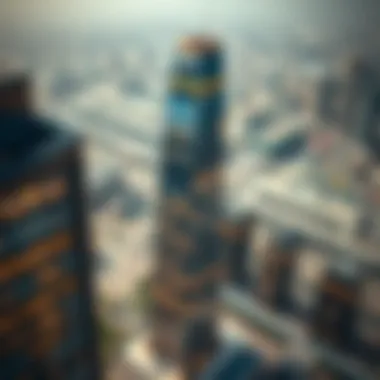
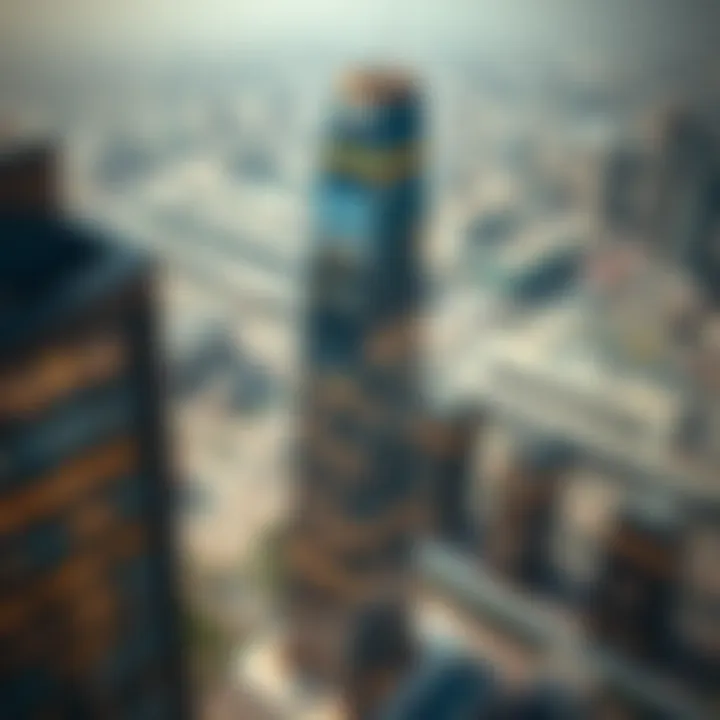
Intro
In the heart of Dubai, where the skyline competes with the horizon, Saif Tower stands as a testament to the city's ambition and innovation. This towering structure is not just a piece of architectural marvel but also a hub for several businesses and ventures. Designed to provide both aesthetic appeal and functional utility, it encapsulates the spirit of modern Dubai—where tradition meets progress.
The allure of Saif Tower lies not only in its unique structure but also in its strategic position within a bustling business environment. As part of the ever-evolving landscape of Dubai's property market, the tower attracts investors, tenants, and tourists alike. While visiting this landmark, one sees the blend of luxurious offices surrounded by vibrant retail spaces, making it a magnet for various commercial activities.
This article aims to cover various facets of Saif Tower, providing a comprehensive overview that speaks to a diverse audience—from investors looking for viable opportunities to individuals seeking knowledge about renting and purchasing spaces in this iconic building. With insights into architectural design, market trends, and practical tips, readers will derive a well-rounded understanding of why Saif Tower is pivotal in the context of Dubai's real estate market.
Intro to Saif Tower
Saif Tower serves as a significant landmark within the urban tapestry of Dubai, blending bold architectural aesthetics with practical commercial spaces. This introduction sets the stage for a deeper investigation into what makes Saif Tower a pivotal piece of Dubai's skyline. As we delve into this exploration, it’s essential to highlight its cultural resonance, architectural appeal, and economic implications that extend far beyond its physical structure.
Overview of Saif Tower
Completed in 2005, Saif Tower stands proudly in the heart of Dubai's bustling financial district. Its unique design, characterized by a sleek silhouette and distinctive triangular shape, draws the eye from nearly every corner of the city. This building is not merely another addition to the skyline; it encapsulates the ambitious spirit of Dubai. The tower stretches over 200 meters high and houses a mix of office and retail spaces, making it an ideal location for businesses looking to establish a presence in a city known for growth and innovation.
Moreover, the tower's name, which translates to "Sword Tower," reflects the historical significance and rich cultural heritage of the United Arab Emirates, serving as a reminder of the region's storied past while embodying the future of urban development.
In essence, Saif Tower is a testament to the stride Dubai has made from a modest trading post into a global hub. The architecture intertwines traditional values with modern needs, making this landmark not just a marvel to observe but also a crucial player in the local economy.
Location and Accessibility
Positioned strategically in Sheikh Zayed Road, Saif Tower benefits from remarkable accessibility. It lies adjacent to vital transportation links, including the Dubai Metro, which offers seamless connectivity throughout the city. This accessibility significantly enhances its allure for businesses and tenants, making it easier for employees and clients alike to navigate their way through one of the busiest areas in the Middle East.
The surrounding area boasts an array of amenities, from fine dining restaurants to high-end shopping centers, making it an attractive place for both workers and visitors. What's more, major highways and the proximity to Dubai International Financial Centre add to its connectivity, drawing a steady influx of professionals and firms.
In summary, Saif Tower's location is strategic, while its architectural elegance and blend of functionality provide significant economic benefits. Whether you are an investor scouting for promising real estate or a corporate entity seeking a prestigious address, Saif Tower stands as a compelling choice.
Architectural Significance
The architectural significance of Saif Tower extends beyond its impressive height and facade. It embodies a remarkable synthesis of aesthetics and functionality, serving as a beacon of contemporary design in the heart of Dubai. This section elaborates on why Saif Tower is a crucial landmark, discussing its distinct architectural style, the materials deployed in its construction, and the innovative engineering techniques that have been implemented.
Architectural Style and Design Elements
Saif Tower showcases a modern architectural style characterized by its sleek lines and striking silhouette. The tower rises like a tall cigar from the ground, adorned with reflective glass that catches the sun and glimmers against the backdrop of Dubai’s skyline. The design elements incorporate subtle curves, giving the structure a dynamic appearance as if it is in perpetual motion.
The facade features a combination of glass and steel, which not only enhances its aesthetic appeal but also contributes to energy efficiency through natural lighting. The rooftop, which offers panoramic views of the city, features a unique crown-like structure that serves as an observation deck. This isn't just a cherry on top—it's a reminder of the building's dual purpose as both a residential and commercial space, accommodating offices that range from fledgling startups to well-established corporations.
Materials Used in Construction
When it comes to materials, Saif Tower stands as a testament to modern engineering and design. The primary materials used in its construction include high-strength concrete, steel reinforcement, and glass panels. Each of these materials was selected with care to ensure durability and longevity, particularly in the extreme climate conditions typical of Dubai.
The use of smart glass plays a pivotal role in reducing energy consumption. This kind of glass can control solar heat gain and maintain comfortable indoor temperatures while maximizing natural light. Steel, known for its strength and corrosion resistance, gives the structure its sturdiness while also allowing for large open spaces within the offices. The combination of these materials not only adheres to local building codes but also reflects Saif Tower's commitment to sustainability and efficiency.
Innovations in Engineering
Saif Tower isn’t just another high-rise; it’s a showcase of engineering marvels. The innovative techniques used during its construction set a new benchmark in the industry. For instance, the tower employs a state-of-the-art structural system designed to withstand high winds, which is a necessary consideration in skyscraper design given Dubai’s windy conditions.
One remarkable feature is its advanced lift system, capable of transporting tenants from ground to the top floor in a matter of seconds. These lifts use a magnetic levitation technology, ensuring smooth and quiet ascents—a significant upgrade over conventional systems.
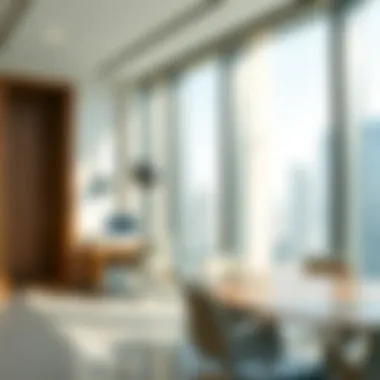
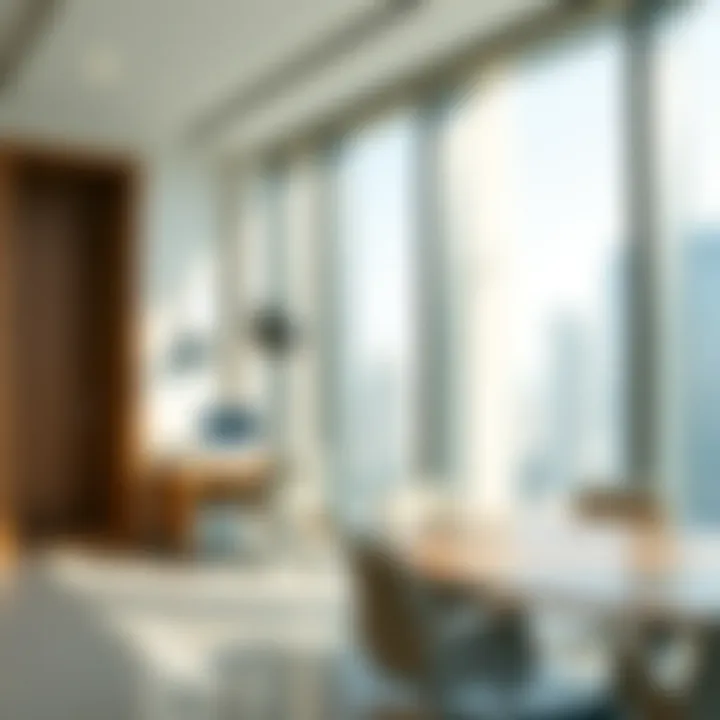
Additionally, the building incorporates green roofing and rainwater harvesting systems, demonstrating a commitment to reducing the ecological footprint. By channeling rainwater for irrigation and using energy-efficient systems, Saif Tower is a prime example of how modern skyscrapers can be both grand and responsible toward the environment.
By uniting state-of-the-art design with innovative construction practices, Saif Tower stands as an enduring symbol of Dubai's architectural prowess.
In summary, the architectural significance of Saif Tower forms an integral part of its identity. It is a fusion of style and substance, designed to meet the demands of modern living while also pushing the boundaries of what can be achieved in skyscraper design. This level of sophistication is crucial not just for aesthetics but also for ensuring the tower remains a pivotal landmark in Dubai’s ever-changing skyline.
Functional Aspects
The operational significance of Saif Tower cannot be understated. This skyscraper operates not just as a pinnacle of modern engineering but also as a critical hub for residential and commercial spaces, supplemented by a suite of amenities, and committed to sustainable practices. Understanding the functional aspects of Saif Tower provides valuable insights into its relevance and position within Dubai's architecture.
Residential and Commercial Spaces
Saif Tower offers a unique blend of residential and commercial accommodations, designed for convenience and modern living. On the upper floors, luxurious apartments with panoramic views provide residents with spacious living environments, while the lower levels are home to commercial offices. This combination allows the building to cater to a diverse set of occupants, from young professionals to multinational corporations.
An excellent feature is the integration of business hubs within the tower, where startups and established businesses share space. The modern office layouts, alongside advanced technology and infrastructure, appeal greatly to companies looking to establish a presence in Dubai's bustling market.
Additionally, the proximity to strategic business districts adds immense value. Companies see Saif Tower as not just a workplace, but an opportunity to network and collaborate, thus reinforcing its utility in the commercial landscape.
Amenities and Facilities
Beyond the premise of simply providing living and working spaces, Saif Tower incorporates various amenities that enhance the quality of life for its occupants. From onsite fitness centers to landscaped gardens, these facilities promote a balanced lifestyle amidst the fast-paced environment of Dubai.
- Healthcare Services: Immediate access to first-rate medical facilities ensures peace of mind for residents.
- Retail Outlets: Several essential services are located at ground level, offering tenants convenience like grocery shopping or dining options, eliminating the need to travel far for basic errands.
- Community Spaces: Shared lounges and meeting rooms foster a sense of community among residents and workers alike.
These amenities not only increase the appeal of Saif Tower but are also pivotal in its marketing strategy, making it a desirable location for both potential tenants and investors.
Sustainability Features
In today’s architectural climate, designing with sustainability in mind is paramount. Saif Tower integrates various green initiatives aimed at minimizing its environmental footprint. This includes energy-efficient lighting systems, rainwater harvesting, and solar panel installations. These choices signify a shift toward more responsible building practices, which can reduce utility costs for tenants and enhance the building's marketability.
Moreover, the tower employs advanced energy management systems which actively monitor consumption patterns, adjusting utility usage in real-time to lower overall energy expenditure.
Another consideration is the use of sustainable materials in the building design, aligning with environmental regulations that are becoming increasingly stringent in Dubai and beyond.
"Incorporating green features into commercial real estate is no longer a choice but a necessity, as modern occupants prefer eco-friendly living and working spaces."
Understanding these functional aspects of Saif Tower helps illuminate its crucial role in Dubai's rapidly evolving landscape. Not only is it a landmark of architectural prowess, but it also serves as a thriving microcosm of urban life, embodying the needs and aspirations of its inhabitants, and pushing toward a more sustainable future.
Historical Context
Understanding the historical context of Saif Tower is crucial to grasp its significance within Dubai's architectural and cultural landscape. This section brings to light the inception of Saif Tower, examining the factors that led to its development and how it reflects the socio-economic evolution of the city. Moreover, exploring its cultural impact sheds light on the tower’s role in shaping the community identity and its emergence as a symbol of progress.
Inception and Development Timeline
Saif Tower's journey began in the early 2000s when the Dubai skyline was transforming rapidly. The early 2000s marked a period of boom in the real estate sector, driven by the increasing influx of businesses and expatriates seeking opportunities in a burgeoning economy.
- 2002: The initial concept took root, driven by design drafts and market analysis. Architects and developers collaborated to create a striking landmark that aligns with Dubai's vision of becoming a global city.
- 2005: Construction commenced, aiming to fulfill a dual purpose: housing leading businesses while providing luxurious spaces for residents. The location was strategically chosen to enhance visibility and accessibility, key elements for a skyscraper in a thriving metropolis.
- 2009: After several years of hard work, Saif Tower was officially opened to the public. It quickly became a centerpiece of the Sheikh Zayed Road area, admired for its unique architectural features and its role in the economy.
The construction of Saif Tower not only contributed to the architectural diversity of Dubai but also marked a significant point in urban development. It encapsulated a shift towards greater vertical living and working spaces, embodying aspirations of luxury and modernity.
Cultural Impact on Dubai
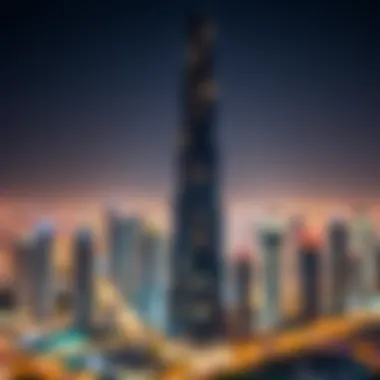

The cultural ramifications of Saif Tower extend beyond its impressive facade. The tower emerged as a cultural touchstone in Dubai, representing the blending of tradition with modernity. Its distinctive design reflects the Arab heritage while embracing contemporary architectural trends.
- Community Hub: The tower serves as a meeting point for local businesses, professionals, and residents. Events and social gatherings frequently take place in its vicinity, fostering community engagement.
- Civic Identity: Saif Tower has taken on an identity of its own, representing a symbol of progress and ambition for both Emiratis and expatriates. It is often highlighted in tourism promotions and is included in city tours as a must-see landmark.
- Art and Culture: The tower's design incorporates elements that pay homage to Islamic art, influencing nearby developments to adopt a similar ethos. It acts as a canvas, inspiring public art initiatives that celebrate the confluence of cultures in Dubai.
As Saif Tower continues to rise against the changing skyline, it remains a testament to Dubai's growth trajectory and cultural narrative, inviting us to reflect on the interplay between architecture, identity, and economic aspirations.
"Buildings are a form of language; they speak to who we are and what we aspire to be. Saif Tower is such an architectural narrative in Dubai's story."
For further information on Saif Tower's architectural significance and its impact on the local community, you can refer to articles on Wikipedia and the Dubai Tourism site.
This historical context not only furnishes valuable insights about Saif Tower but also serves as a reminder of the vibrant urban tapestry that continues to weave itself in Dubai.
Market Trends
Understanding the market trends surrounding Saif Tower is vital for comprehensively assessing its role in Dubai's rapid real estate evolution. This section aims to unpack various facets of the current marketplace dynamics, the investment potential tied to the tower, and how it stacks up against similar structures in the region. Grasping these elements not only augments investors' insights but also aids potential buyers and real estate agents in making informed decisions.
Current Market Dynamics
The current market dynamics of the Dubai real estate landscape are a reflection of both local and global factors. Saif Tower stands out as a prime example of a property that embodies strong investment interest due to its strategic location and unique architectural features.
Several factors shape current dynamics:
- Demand vs. Supply: The demand for premium commercial spaces in Dubai, especially in well-established business hubs, remains robust. Saif Tower, catering to both residential and commercial needs, capitalizes on this trend.
- Rental Yields: Properties like Saif Tower often yield higher rental returns compared to conventional assets, making them appealing to investors looking for consistent income.
- Regulatory Environment: Dubai’s real estate regulations have also evolved, attracting international investors who feel more secure with clearer guidelines regarding ownership and leasing.
These dynamics reinforce Saif Tower’s position as a lucrative option for stakeholders eager to engage in Dubai’s ever-shifting market.
Investment Potential
The investment potential of Saif Tower can’t be overstated. A few key characteristics bolster its attractiveness:
- High Visibility: Positioned in the heart of Dubai, Saif Tower enjoys a bustling atmosphere with consistent foot traffic. This feature typically ensures high demand for leasing.
- Modern Amenities: Equipped with state-of-the-art facilities that appeal to businesses and residents alike, the tower serves as a dual-niche investment opportunity.
- Market Resilience: As business operations in Dubai continue to rebound post-pandemic, well-placed assets such as Saif Tower have shown resilience, promising a steady appreciation in value over time.
Investors are eyeing Saif Tower not just as a physical asset but as a long-term proposition that could yield substantial returns.
Comparative Analysis with Other Towers
To further appreciate Saif Tower’s standing in the real estate market, one can compare it with other iconic towers in Dubai, such as the Burj Khalifa and the Emirates Towers. Here’s how they compare in various aspects:
- Size and Height: While Saif Tower may not have the towering height of Burj Khalifa, it competes well in the realm of usable office space, having a practical footprint that smaller competitors lack.
- Location: Both Saif Tower and the Emirates Towers share prime locations but attract different clientele. Saif Tower's more diverse offerings appeals to a wider range of businesses.
- Facilities: While towers like Burj Khalifa feature luxurious amenities, Saif Tower focuses on practicality and efficiency, ensuring that it attracts tenants looking for functionality rather than just ostentation.
With such comparisons, it's clear that Saif Tower holds its ground firmly amid the diverse offerings in Dubai's skyline, appealing to investors looking for a balance of prestige and practicality.
Saif Tower in the Context of Dubai's Real Estate Landscape
Saif Tower stands prominently within the intricate web of Dubai's real estate market, often acting as a barometer for the overall health of the area’s property landscape. This skyscraper is not merely a structure of glass and steel; it serves as a vital catalyst for business, investment, and economic growth in its vicinity. The significance of Saif Tower in this context can’t be overstated, as it not only attracts tenants but also influences the patterns of business operations and commercial dynamics in Dubai.
Positioning Within the Market
Positioning in the market—while it may sound like a simple enough concept—is a nuanced affair. Saif Tower has carved out a niche as both a premier business destination and a residential haven. Its strategic location in the heart of Dubai makes it exceptionally attractive for both international firms and local enterprises. The tower is surrounded by various commercial facilities, retail outlets, and transport connections, which significantly amplifies its desirability.
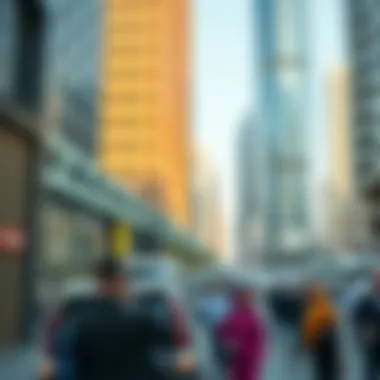

- Accessibility: With easy connectivity to major roads and public transport, tenants can enjoy a seamless commute, enhancing employee satisfaction and productivity.
- Competitive Edge: In a city known for its fierce competition among high-rises, Saif Tower secures its place by offering advanced amenities, contemporary design, and a prime location that many other buildings strive to match.
- Tenant Diversity: The mix of both long-term residential and commercial tenants provides stability, thereby attracting investors looking for reliable returns.
This strategic positioning not only ensures high occupancy rates but also plays a significant role in determining rental values. As demand for office spaces grows within Dubai, Saif Tower’s standing rises concurrently, reinforcing its reputation as a premier asset.
Influence on Local Business Trends
The ripple effects of Saif Tower extend far beyond its walls. The presence of this iconic building influences local business trends, impacting everything from job creation to consumer behaviors in the area. One of the most notable aspects of its influence is how it shapes the local economy—affecting everything from property values to the competitive landscape among businesses.
- Job Creation: The tower hosts various multinational companies which subsequently create job opportunities for local professionals, thereby stimulating economic activity.
- Consumerism: Enhanced foot traffic due to the tower encourages surrounding businesses to thrive. Cafes, shops, and service providers often benefit from the increased visibility and patronage that comes with a busy workday.
- Real Estate Value: As the demand for commercial space grows, the prices for nearby properties often see upward pressure. This effect can attract new developments, creating a cycle of growth in the area.
In summary, the influence of Saif Tower on local business trends illustrates the interconnected nature of commercial real estate and the broader economic landscape in Dubai. With its strategic positioning and direct impact on job creation and consumer behavior, Saif Tower represents a linchpin in the evolving narrative of Dubai's economic landscape.
"The success of Saif Tower is a testament to how a single structure can catalyze growth, influence local business trends, and shape the future of a bustling city like Dubai."
For more insight, consider exploring resources like Wikipedia and Britannica, which delve into both the architectural and economic aspects of this iconic landmark.
Future Projections
In the realm of real estate, understanding future projections is not merely a luxury, but a necessity. Especially for stakeholders interested in Saif Tower, grasping the expected developments and long-term value is crucial. These projections are pivotal for investors, property managers, and tenants alike, as they provide a lens through which one can analyze potential growth, market stability, and the evolving character of Dubai’s commercial landscape. The dynamic nature of real estate necessitates a thorough examination, considering factors like economic trends, urbanization, and the long-term vision of Dubai's development.
Anticipated Developments
The Saif Tower is not just a static structure; it is part of a constantly evolving urban tapestry. Several factors point towards exciting anticipated developments that could enhance the tower's prominence:
- Infrastructure Improvements: As Dubai continues to invest heavily in its infrastructure, further enhancements around Saif Tower are likely. This includes better access roads, enhanced public transport connections, and smart city technologies that increase convenience for both residents and businesses.
- Cultural and Commercial Initiatives: The area surrounding Saif Tower is ripe for the development of cultural hubs or commercial centers. City planners are increasingly focused on creating spaces that foster creativity and community engagement, which could significantly boost the attractiveness of the Tower as a prime location for companies and startups.
- Green Initiatives and Smart Technology: With sustainability becoming a cornerstone of modern architecture, it is worth noting that future developments may incorporate more eco-friendly practices. This could manifest in energy-efficient systems installed in the tower, aligning with Dubai’s vision for sustainable urban growth. Buildings that heartily embrace green initiatives generally enjoy higher demand and property values.
Long-term Value Forecast
When we look at the long-term value forecast for Saif Tower, several variables come into play. Understanding these variables can help stakeholders make educated decisions regarding their investments:
- Market Demand: There is growing interest in Dubai's commercial real estate. As international businesses look to capitalize on the strategic location and the ongoing economic diversification in the UAE, demand for spaces like Saif Tower is expected to rise.
- Property Valuation Trends: Over the years, the value of properties within Dubai has seen a cyclical pattern, driven by both local and global investment climates. With expert prediction, the sub-sector where Saif Tower sits may witness appreciation in property values, especially as more infrastructure and amenities come to the area.
- Risk Considerations: While the future holds potential, it is also important to be aware of risks. Economic fluctuations or shifts in government regulations may impact the stability of property investments. However, the resilience of the Dubai real estate sector offers reassurance to many investors.
"Investors must keep a close eye on the prevailing trends and be adaptable to changes in the market landscape for optimal returns."
In summary, future projections regarding Saif Tower reflect a landscape rich in opportunity. Potential developments alongside sound predictions indicate a strong possibility of maintaining or even enhancing its stature in Dubai's illustrious skyline.
Culmination
The conclusion of this exploration serves to underscore significant findings about Saif Tower. This landmark is not just a striking piece of architecture, but it represents an entire era of growth and aspirational living in Dubai. Understanding the multifaceted role of Saif Tower gives investors, buyers, and other stakeholders a contextual backdrop to evaluate its relevance confidently.
Summary of Insights
When we take a step back and review the aspects laid out in this article, several key insights emerge:
- Architectural Marvel: Saif Tower stands as a beacon of modern design, emphasizing not just aesthetics but functionality.
- Strategic Location: Its positioning within Dubai enhances its appeal, making it easily accessible from various commercial and residential hubs.
- Investment Appeal: With the growth of the area around it, the tower shows promising trends that make it an attractive option for investors looking for longevity and value retention.
- Sustainability Considerations: The tower’s unique features relating to sustainability place it not just as a physical structure but as a socially responsible investment.
These insights highlight the complex layers that make Saif Tower a critical topic for those involved in Dubai's property market.
Final Thoughts
In wrapping up the discussion on Saif Tower, it becomes clear that this skyscraper is not merely about height or style—it weaves into the very fabric of Dubai's identity. The massive echo it has in the employment sector, as well as its significance within the local business environment, marks it as a strong player in Dubai's real estate game. Investors looking to capitalize on the evolving landscape should consider the tower not just for its current offerings but for its future potential.
To delve deeper about Saif Tower and understand its continuous impact on real estate, you can visit these resources:
By integrating these insights into investment strategies or urban planning, stakeholders can better navigate the opportunities presented by Saif Tower and its surroundings.
